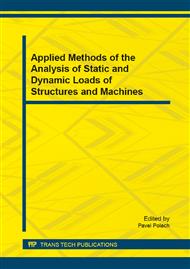p.329
p.333
p.337
p.341
p.345
p.349
p.353
p.357
p.365
Experimental Verification of a Computing Model
Abstract:
The finite element method and Component element method are widely used in modeling nowadays. Also the classical computing models especially discrete computing models give very good results. Often some assumptions must be adopted in the process of creation of computing models especially within creation of bridge computing models. In such a case the experimental tests are needed to verify the validity of adopted assumptions. The presented paper describes the adopted assumptions and methodology of their experimental verification. It mutually compares the experimentally and numerically obtained results and makes findings for practical applications.
Info:
Periodical:
Pages:
345-348
Citation:
Online since:
February 2015
Authors:
Price:
Сopyright:
© 2015 Trans Tech Publications Ltd. All Rights Reserved
Share:
Citation:


